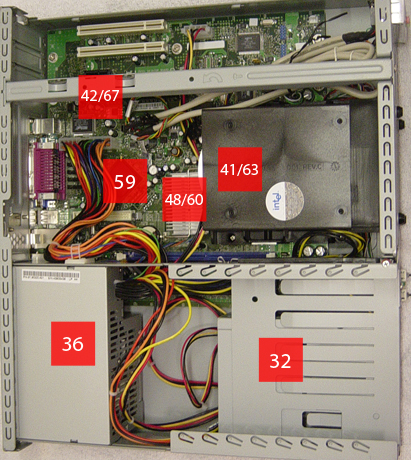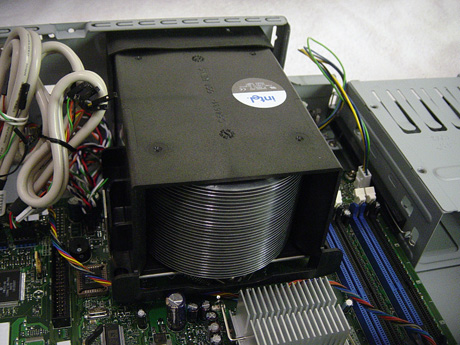Intel's Long Awaited BTX Form Factor
by Purav Sanghani on November 15, 2004 5:31 AM EST- Posted in
- Cases/Cooling/PSUs
Thermals Micro BTX (uBTX)
This is where everything we have heard about the BTX form factor is either proven right or wrong. Intel claims BTX the better design to efficiently cool more components with less equipment while using less power and space. Intel released a virtual press kit on their BTX form factor in April of this year. Unfortunately, the press kit is a little too general to really draw many conclusions, but feel free to judge for yourself.Intel's press kit reports that the BTX design cools the CPU to 2 degrees lower than the ATX form factor while only providing 40 cubic feet per minute, or 40 cfm with our Type I Thermal Module. ATX, on the other hand, requires 150 linear feet per minute, or 150 lfm.
We performed our inch by inch temperature observation with the D915GMH microBTX motherboard and the Pentium 550 CPU in the AOpen B300 which is 15" in width by 13" in depth.

Click to Enlarge
From our results above we see that the temperatures of each square inch of the case are a few degrees higher than those we found on our ATX Ahanix D.Vine 5 chassis. The warmest pocket of air hovers between the PCIe card, Southbridge, Northbridge, and CPU. This area, which averages about 35 degrees, is warmer than the ATX ambient average of about 32 degrees. Intel's whitepaper was not clear on the equipment they used to get the results in their table but from our results, the standard ATX system performs cooler than the BTX system. The microATX system, however, produced temperatures higher than those of the microBTX system.

Click to Enlarge
The results for the core temperatures of each component shown above also tell us that the microBTX equipment does not exactly perform better than the ATX hardware, but for the amount of fans in the system, microBTX is more efficient when it comes to cost of energy and space. With only the CPU's HSF and the power supply's single 80mm fan, the uBTX system performs at temperatures lower than an uATX system with three case fans and a dedicated CPU HSF.

Click to Enlarge
These temperatures are not set in stone for every processor Intel manufacturers or will release in the future. Each will require a different thermal module according to their Thermal Design Power rating. For example, The Pentium 550J will come bundled with a Type I Stacked-fin module whereas the Pentium 560J will come with the Type I Spiral-fin module. Obviously the spiral-fin module will dissipate heat better than the stacked fins.










77 Comments
View All Comments
HardwareD00d - Monday, November 15, 2004 - link
Instead of spending all the money to research BTX, Intel should have just made watercooling standard on the Prescott CPU. Apple could have said they stole the idea from them like everything else ;)Omega215D - Monday, November 15, 2004 - link
It looks like Intel needs all the cooling it can get. I found an interesting article at Toms Hardware and here;s the closer about its heat problem "So, should a vendor release a product that is only able to run at its maximum performance under special circumstances? The fastest processors certainly are very exclusive devices, but that should not cause more troubles than necessary. The customer wants products that simply work! Think about that before releasing faster products, Intel." All I can say is wow, because I can remember my P3 866 didn't need all that cooling though now I moved on to AMD.HardwareD00d - Monday, November 15, 2004 - link
It sounds like you can essentially get the same thermal performance from an ATX case by adding 1 additional case fan.At least Intel has decided not to push this new form factor down peoples throats. Honestly, that's what I figured they'd try to do.
Gatak - Monday, November 15, 2004 - link
To have the powersupply and drive bays at the bottom is a good thing. It will keep the temperature more balanced inside the case and also provide more room at the top for cards and for exhaust fans, rather than craming everything up there.Pythias - Monday, November 15, 2004 - link
ROFL #6!!Ecmaster76 - Monday, November 15, 2004 - link
If a retail board showed up to a review with that horrible a component layout, it would be figuratively flogged.I find that the review was somewhat flawed since it failed to see what would happen with a discrete graphics card in the box. If one was used, I didn't spot it in the screenshot of the full ATX or uBTX screeshots, and it wasn't mentioned in the text.
Finally it should be mentioned that many people have theorized that the BTX layout would not work well for the Athlon64's onboard memory controller because of issues with trace layout. I'm no expert, but it does look like it might get a little tight.
ksherman - Monday, November 15, 2004 - link
"Anand's *vacation* work trip to Taipei..."Probably one of the funniest things i have read in one of your reviews.... ;)
raskren - Monday, November 15, 2004 - link
As always, so much Intel backlash, simply because, its Intel.This is how cases should have been done originally. Align all the hot components and put a fan in front and behind them. Makes sense, right?
Current ATX design is "put a fan on every hot item you have". At least that's how my case is.
LoneWolf15 - Monday, November 15, 2004 - link
To me, BTX looks like a winner for only one niche: small form factor business desktops. By that definition, I don't include Shuttle's wonderful SFF PC's which work best for home and HTPC enthusiasts. The microBTX form factor looks great for an office environment where quiet operation is a real plus, as well as power consumption, and since business PC's don't need to be cutting-edge, middle-end processors can be used that don't generate a lot of heat.Tor the enthusiast however, BTX looks like a bust to me, more of an attempt by Intel to throw the market out of whack, specifically AMD's market. Enthusiasts already have case designs meant to exhaust a lot of air and keep systems cool. Many enthusiasts LIKE a little bit larger case so that they have more expansion room, with the exception of their HTPC, and so that they can house a decent power supply for that expansion.
I see HP, Compaq, IBM, and other mainstream business computing giants adopting BTX; it will probably do well in the business market as well as in mass retail, where OEMs would rather make a system with less fans to fail and at cheaper cost. That's a pretty big sector for profit of course, but this form factor, IMO, leaves PC enthusiasts out in the cold.
Beenthere - Monday, November 15, 2004 - link
BTX is obviously NOT a great design. Intel changes sockets, Mobo and other specs periodically to FORCE people to update to their latest crap. Don't expect a rush to BTX. It's another Intel spec unlikely to ever gain foothold...For those who don't already know you can do wonders for ATX case cooling with "managed airflow". By actually directing incoming cool air to the heat sources and isolating the CPU fan from warm air in the case, no one really needs a BTX case and your PC will run much cooler with managed airflow.
While Intel definitely needs a tornado inside a box to cool their defective 90 nano CPUs, the BTX standard is just another Intel marketing scam for all practical purposes.
Just say NO !